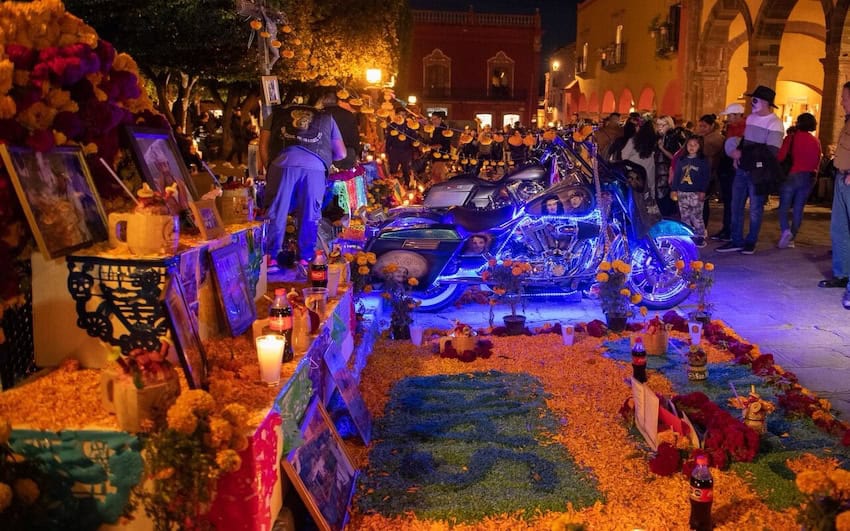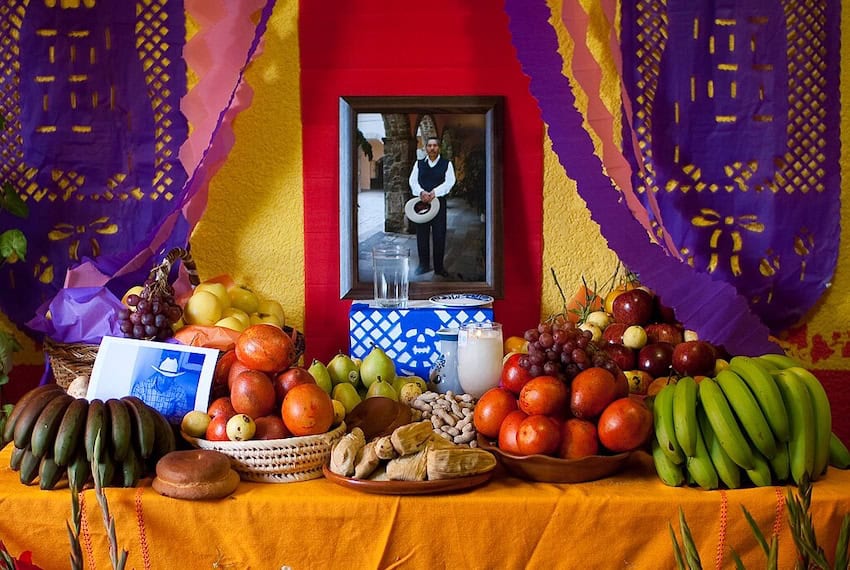As San Miguel de Allende adorns its doorways with iconic sun-hued cempasúchil and purple velvet flowers resembling rooster combs, the town’s hotels will reach capacity with an influx of tourists from Mexico City and the world. Many will experience the mystical allure of Día de Muertos for the first time — including my own toddler twin boys. Born in this town and carrying both Mexican and Burmese American heritage, the pressure is on for me as their foreign-born mother to deliver a memory that is both age-appropriate and resonant with their cultural roots.
But tradition isn’t a stagnant concept, nor is it merely the sum of the material objects that have been gingerly collected and preserved over generations to mark the occasion. To help me sift through what is essential for anyone who can count themselves lucky enough to be part of this year’s Día de Muertos festivities in San Miguel de Allende, I called up Nancy Hoch, the owner of the community hub Geek & Coffee for over a decade. The 39-year-old mother and San Miguel native is proudly descended from a 200-year paternal lineage that is indigenous to this area. Hoch’s father is the President of Costumbres y Tradiciones, a nonprofit organization dedicated to fostering and maintaining an understanding of the longstanding patrimony of San Miguel de Allende. Each year, they work to bridge the divide between locals and foreigners.

Acknowledging the ‘living tradition’
“Our traditions are alive; they never died,” said Hoch. “We are not remembering anything, we’re simply living them. Unlike in say the United States, we’re not remembering something that was lost, we’re living the continuation of our traditions.”
She went on to share that Catrinas, with their extravagant flower crowns and full-length gowns, are a relatively new addition to the Day, emerging over the last hundred years or so. And so, for those wondering about the relevance or “acceptability” of stepping into the parade in elegant dress, adelante, go ahead and strut your stuff. As Hoch explained, “These are living traditions, and our kids have the right to continue building on them as much as our ancestors did.”
It’s also common on Halloween in San Miguel for gringos to gleefully dole out candy in the main square, the Jardín Allende. My own children will be there, hand in hand this year, disguised as Batman and Robin. If anyone is perplexed by these two holidays colliding, and the potential confusion it may cause for our little ones, Hoch says they’re not so different after all.
Centuries ago, during harvest festivals, farmers and their families would ask for piloncillo and other sweets to cook their pumpkins. Still today, you’ll hear the Mexican youth ask, “Dame para mi calaverita,” a hollowed-out Jack-o-Lantern in hand, hoping to carry sweetness into the following year. Hoch said this is as close to Mexican Halloween as it gets (though not to be conflated with Día de Muertos whatsoever).
“You guys can face paint, and we can trick-or-treat. It’s cool,” she laughed. “Have we modified this practice? Yes. Is it also part of our Mexican Indigenous traditions? Also, yes.”
Private vs. public: Respect the difference
Hoch says that Mexicans intentionally mark the occasion in both private and public ways. For instance, the ephemeral artistic carpet ofrendas in Centro, made of sawdust, sand, and earth, are purposefully meant to be seen and shared. But the biggest faux pas and offense a non-Miguelense can make is to go on a tour of a cemetery or the Pantheon on November 2.
Many locals say that these types of tours should be outright banned, and foreigners often struggle to walk the fine line of participation in this liminal time of year and voyeurism. Hoch wants people to heed her primary caution: “Don’t go to cemeteries on November 2 if you don’t have someone buried there. If you do not know them by name or know where that stone is, don’t go.” The day before the nationally recognized Día de Muertos, November 1, is also a particularly tender time. Grieving mothers and fathers spend it honoring children who have died.
Instead, there are plenty of other places to practice quiet contemplation, starting with your own home. If you’re hesitant to build an altar, consider befriending a local and lighting candles with them in their space. Last week, a friend of mine from Mexico City, whose daughter is the same age as my twins, welcomed us into her annual ritual of playing “La Llorona” on repeat, eating pan de muerto, sipping cardamom-spiced hot chocolate, and reciting orations while illuminating the altar for the first time during the month she’ll keep it on display. It dawned on me that, for the first time, I was saying the names of my maternal grandparents out loud to them. Even though my twins hold no personal memories of Eleanor and Edward, seeing her parents honored was comforting to my Burmese mother, as she fully immersed herself in the ways of her host country.
No permission, no picture

In the Instagram era, taking photos is a hot topic in general, especially for protective and concerned parents and families. I was mortified when Nancy told me that last year, a 20-something social media “influencer” removed a photograph her father had put up of one of their departed loved ones to replace it with her own logo for a clickbait shot. Rudely awakened from his silent memorializing, he nearly spat out his tequila — I would have done much worse.
Hoch wanted me to know that the issue isn’t taking photographs so much as it is where, when, and whether or not you’ve requested explicit permission from the people you’re capturing on film. “I have an ofrenda up at Geek & Coffee, and you are welcome to take a picture of it. It’s meant to be shared,” Hoch told me. “But you are not welcome to take photos of my son placing flowers on a grave.” Categorically, photos in any cemetery are off limits. When attending a public event, such as the Día de Muertos parade, it’s worth reminding yourself to always ask permission before capturing the moment, especially if children are in the frame. It’s easy to be swept up in the extravagance, but pause to consider that heartfelt mourning and reflecting on the fragility of life are pulsing all around you. This is part and parcel of honoring the thinning of the veil with reverence and respect for the dead on their sacred day of homecoming.
Not if, but how
Generally, Mexicans are known for being generous and inclusive, particularly with their food, customs, and hospitality. They want to invite us into their vivid, ever-evolving world of dancing skeletons and petal-lined paths, delicately built so the ancestors can find their way home.
And let’s not ignore the elephant in the room about Catrina face painting: In 2023, Guadalajara native Gabriela Solís argued in this same publication that, yes, it is generally acceptable for foreigners to paint their faces (except in certain circumstances; read on for more about the historical context of her conclusion). Ultimately, it doesn’t matter where you come from on Día de Muertos, as we are all marching toward the same eventuality. What lives on or emerges from the inevitably expanding tradition of opening our doors, streets, and hearts to the return of our loved ones’ spirits will be shaped by past, present, and future.
As a culturally complex family, we aren’t religious, but Nancy’s final words will resonate deeply with us throughout the upcoming weekend: “Everybody loves the idea of being remembered. At the end of the day, we all hope somebody’s gonna put our picture up.”
Simone Jacobson is a Burmese American cultural connector, toddler twin mama and writer based in San Miguel de Allende. By day, she is the Content Director for Well Spirit Collective. In all other moments, she strives to raise compassionate children who never lose their curiosity, tenderness and radiant light. Read more by Simone here.
